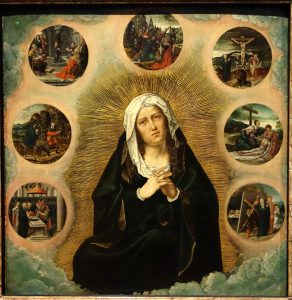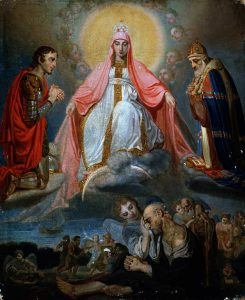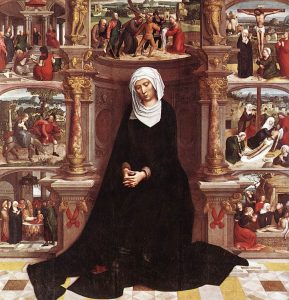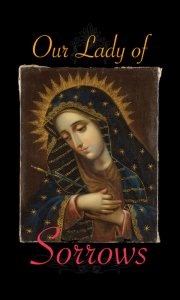
The Feast of Our Lady of Sorrows, which takes place every year on September 15th, offers a window into the suffering heart of the Blessed Virgin Mary.
By venerating Mary’s sorrows, we come to better understand the depth of her love and her role in our salvation. Today we explore this devotion from its origins to the present day.
The devotion to Our Lady of Sorrows dates back to the early Christian era but took on a formalized shape in the 12th century with the Cistercians and the Order of Servites.
“The grief of Mary was so great that, were it divided amongst all men, it would suffice to cause their immediate death.” –St. Alphonsus Liguori
The Cistercians
The Cistercian Order was founded in the late 11th century as a reform movement seeking a return to a more austere and contemplative monastic life.
 The Cistercians, known for their deep devotion to the Blessed Virgin Mary, were instrumental in popularizing Marian feasts and spreading Marian theology. It was within this setting of profound Marian piety that the devotion to the Sorrows of Mary found fertile ground.
The Cistercians, known for their deep devotion to the Blessed Virgin Mary, were instrumental in popularizing Marian feasts and spreading Marian theology. It was within this setting of profound Marian piety that the devotion to the Sorrows of Mary found fertile ground.
In their liturgical texts and through their writings, the Cistercians began emphasizing the human aspects of Mary’s life, including her sorrowful experiences like the Flight into Egypt or standing at the foot of the Cross. This was an extension of their broader focus on the Incarnation and the humanity of Christ.
The Cistercians were among the first to introduce a liturgical commemoration of the Sorrows of Mary, though it was not yet a formalized feast at this point.
The Servites
The Servites took up the cause of the Sorrows of Mary with great fervor. They were instrumental in systematizing the devotion around the Seven Sorrows, providing a structured form of meditation that became the Seven Sorrows Rosary. Moreover, the Servites popularized the feast itself, not just within their own order but across the broader Church, leading to its eventual inclusion in the Roman Missal by the 17th century.
Founded in 1233, the Order of Servants of Mary (commonly known as the Servites) was established by a group of seven men from Florence, Italy. From the outset, the Servites had a strong Marian orientation, dedicating themselves to meditating on the life and virtues of the Blessed Virgin Mary.
“Let us endeavor, like so many elect souls, to follow this most Blessed Mother, to walk always very close to Her, not following any other path that leads to life, except the one trod by our beloved Mother.” –St. Padre Pio
Devotion

Though coming from different periods and spiritual emphases, both the Cistercians and the Servites contributed to the cultivation and spread of the devotion to Our Lady of Sorrows.
The Cistercians laid the initial groundwork by weaving the theme of Mary’s sorrow into their liturgy and theological reflections, helping to instill it into the broader devotional life of the Church. The Servites built upon this foundation by systematizing the devotion, organizing it around the Seven Sorrows, and actively promoting the feast itself.
The combined influence of the Cistercians and Servites made the devotion to Our Lady of Sorrows deeply ingrained in Catholic spirituality. Their contributions were so impactful that in 1814, Pope Pius VII extended the feast to the universal Church.
 By the 14th century, the feast had gained a secure place in the liturgical calendar, initially observed on the Friday before Palm Sunday. However, it was later moved to September 15th, the day following the Feast of the Exaltation of the Holy Cross, to create a meaningful juxtaposition of the Cross and the Sorrows of Mary.
By the 14th century, the feast had gained a secure place in the liturgical calendar, initially observed on the Friday before Palm Sunday. However, it was later moved to September 15th, the day following the Feast of the Exaltation of the Holy Cross, to create a meaningful juxtaposition of the Cross and the Sorrows of Mary.
Additionally, the Seven Sorrows Rosary, largely promoted by the Servites, gained widespread adoption among the faithful as a form of meditation not only on Mary’s sorrows but also on the Passion of Christ.
“There is no sinner in the world, however much at enmity with God who cannot recover God’s grace by recourse to Mary.” –St. Bridget of Sweden
Observation
Historically, the feast involved penitential processions, hymns, and sermons focusing on Mary’s sufferings.
 Today, the day is marked by special liturgical observances and is often accompanied by the recitation of the Seven Sorrows Rosary, which takes the devotee through the seven key moments of sorrow in Mary’s life.
Today, the day is marked by special liturgical observances and is often accompanied by the recitation of the Seven Sorrows Rosary, which takes the devotee through the seven key moments of sorrow in Mary’s life.
The Seven Sorrows Rosary is a chaplet that commemorates Mary’s seven sorrows, each linked to a specific Biblical event, such as the Prophecy of Simeon (Luke 2:34-35), the Crucifixion and Death of Jesus (John 19:25-30), and the Burial of Jesus (John 19:38-42).
In many cultures, it is also a day for visiting Marian shrines specifically dedicated to Our Lady of Sorrows.
Shrines
- Basilica of Our Lady of Sorrows in Chicago, USA: A focal point for the devotion in North America.
- The Sanctuary of Our Lady of Sorrows in Kibeho, Rwanda: This shrine is especially poignant, given the sorrows experienced in Rwanda’s own history.
- Our Lady of Sorrows in Šiluva, Lithuania: One of the oldest Marian shrines in Europe, attracting pilgrims especially around the feast.
The Feast of Our Lady of Sorrows serves as a potent reminder of the depth of love and sorrow Mary experienced, drawing us closer to her compassionate heart.
The devotion invites us to unite our own sufferings with Mary, and through her, to the redemptive suffering of Christ. It’s a profound feast, not only rooted in tradition but also deeply relevant to our own times, reminding us that even in sorrow, we are never alone.
Our Lady of Sorrows Devotionals
Available now at CatholicShop.com
Seven Sorrows Rosary
Seven Sorrows Gift Set




